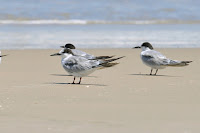COMMON TERN
COMMON TERN – (Sterna hirundo) – (See images below)
DESCRIPTION: The Common Tern has a black cap that covers the eye area, light grey upper parts, white under parts, and a sharp red bill with a black tip. The legs are red-orange. Both sexes are similar. Juveniles have a brownish head, a black bill and dark legs. It is around 30 cm (12 in.) long.
VOICE: https://www.xeno-canto.org/species/Sterna-hirundo
NAME: The English name (as well as the Latin genus name ‘Sterna’) is derived from Old English ‘stearn’. The Latin species name ‘hirundo’ stems from some resemblance of this bird with the swallow, although the two species are not related. The common tern is also called ‘sea swallow’ sometimes however.
HABITAT: Lake and coastal marshes and beaches, and small islands.
DIET: As with other terns, this species feeds on fish by plunge diving from a short height. They are able to drink salt water, as their anatomy can filter out the salt from the water.
NESTING: This tern breeds in colonies that can reach several thousand nests, and might share the nesting site with other tern species or gulls. An average of two light blue-green eggs are laid, which are incubated by both parents, who also both feed the young.
DISTRIBUTION: The common tern is widely distributed around the world. Its breeding range covers most of the northern hemisphere, and the wintering range includes a good part of the coastal areas in the southern hemisphere. Some vagrants have been reported in Hawaii. (Please see note below for information on bird vagrancy.)
DISTRIBUTION MAP: https://en.wikipedia.org/wiki/Common_tern#/media/File:SternaHirundoIUCNver2018_2.png
ON PEI: The common tern breeds on Prince Edward Island, and is listed as ‘common’ to ‘very common’ depending on the seasons.
CONSERVATION: The common tern was subjected to hunting for its feathers in the past, and sometimes the entire bird was used for hats. In spite of the overall population being stable, there has been a decline in the North American population of this bird in the last decades. It is however not considered at risk at the present time. The nesting sites of this species are vulnerable to predation, notably by gulls, and to human disturbance. When disturbed, common terns might not even go back to their nests.
NOTES: The common tern is part of the large gull family.
Vagrancy: In biology this means an animal going way outside its normal range. For birds, this can happen when there are storms and they get blown off course. On other times, the bird simply wanders in a different direction than usual. Here’s an article about vagrancy in birds.
SIMILAR SPECIES: Arctic Tern, Caspian Tern
REFERENCES: https://en.wikipedia.org/wiki/Common_tern
https://www.allaboutbirds.org/guide/Common_Tern/id
https://www.borealbirds.org/bird/common-tern
https://www.mba-aom.ca/jsp/toc.jsp (Maritimes Breeding Bird Atlas)
http://www.natureconservancy.ca/en/what-we-do/resource-centre/featured-species/birds/common-tern.html
https://www.dec.ny.gov/animals/7100.html
https://www.audubon.org/field-guide/bird/common-tern
DESCRIPTION: The Common Tern has a black cap that covers the eye area, light grey upper parts, white under parts, and a sharp red bill with a black tip. The legs are red-orange. Both sexes are similar. Juveniles have a brownish head, a black bill and dark legs. It is around 30 cm (12 in.) long.
VOICE: https://www.xeno-canto.org/species/Sterna-hirundo
NAME: The English name (as well as the Latin genus name ‘Sterna’) is derived from Old English ‘stearn’. The Latin species name ‘hirundo’ stems from some resemblance of this bird with the swallow, although the two species are not related. The common tern is also called ‘sea swallow’ sometimes however.
HABITAT: Lake and coastal marshes and beaches, and small islands.
DIET: As with other terns, this species feeds on fish by plunge diving from a short height. They are able to drink salt water, as their anatomy can filter out the salt from the water.
NESTING: This tern breeds in colonies that can reach several thousand nests, and might share the nesting site with other tern species or gulls. An average of two light blue-green eggs are laid, which are incubated by both parents, who also both feed the young.
DISTRIBUTION: The common tern is widely distributed around the world. Its breeding range covers most of the northern hemisphere, and the wintering range includes a good part of the coastal areas in the southern hemisphere. Some vagrants have been reported in Hawaii. (Please see note below for information on bird vagrancy.)
DISTRIBUTION MAP: https://en.wikipedia.org/wiki/Common_tern#/media/File:SternaHirundoIUCNver2018_2.png
ON PEI: The common tern breeds on Prince Edward Island, and is listed as ‘common’ to ‘very common’ depending on the seasons.
CONSERVATION: The common tern was subjected to hunting for its feathers in the past, and sometimes the entire bird was used for hats. In spite of the overall population being stable, there has been a decline in the North American population of this bird in the last decades. It is however not considered at risk at the present time. The nesting sites of this species are vulnerable to predation, notably by gulls, and to human disturbance. When disturbed, common terns might not even go back to their nests.
NOTES: The common tern is part of the large gull family.
Vagrancy: In biology this means an animal going way outside its normal range. For birds, this can happen when there are storms and they get blown off course. On other times, the bird simply wanders in a different direction than usual. Here’s an article about vagrancy in birds.
SIMILAR SPECIES: Arctic Tern, Caspian Tern
REFERENCES: https://en.wikipedia.org/wiki/Common_tern
https://www.allaboutbirds.org/guide/Common_Tern/id
https://www.borealbirds.org/bird/common-tern
https://www.mba-aom.ca/jsp/toc.jsp (Maritimes Breeding Bird Atlas)
http://www.natureconservancy.ca/en/what-we-do/resource-centre/featured-species/birds/common-tern.html
https://www.dec.ny.gov/animals/7100.html
https://www.audubon.org/field-guide/bird/common-tern
 |
| Common tern with fish, Fire Island, NY photo by Badjoby |
 |
| Common terns, nonbreeding plumage Rio Grande do Sul, Brazil by Claudio Dias Timm |
 |
| Common tern chick, Protected Island off Maine - photo by Charles Homler |
 |
| Common tern, Deltebre, Spain - June 25, 2017, by Roberta Palmer |
 |
| Common tern close up, breeding plumage Nantucket NWR, MA, Amanda Boyd, USFWS |